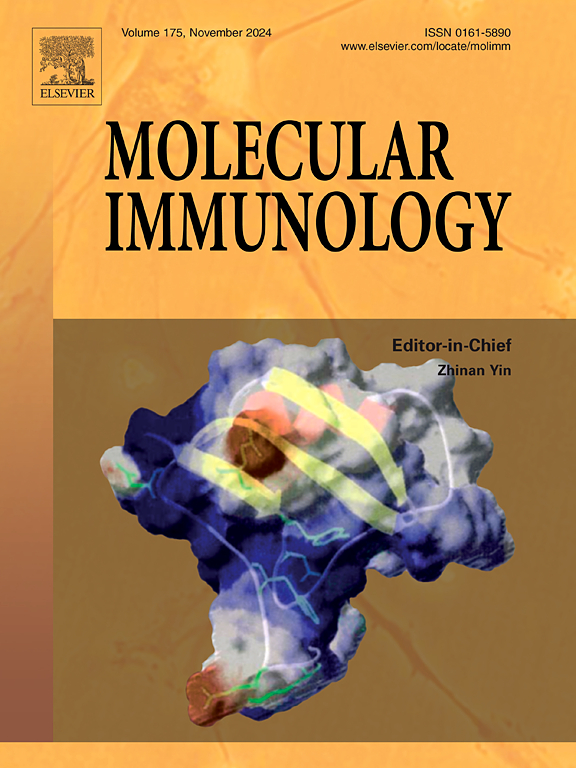不同毒力刚地弓形虫感染巨噬细胞的转录组学比较分析,为巨噬细胞吞噬和极化对感染的反应提供了分子视角
IF 3
3区 医学
Q2 BIOCHEMISTRY & MOLECULAR BIOLOGY
引用次数: 0
摘要
巨噬细胞对刚地弓形虫的增殖和传播至关重要。调节巨噬细胞活化改善炎症环境是治疗疾病的有效途径。然而,弓形虫改变巨噬细胞功能的分子机制尚不清楚。基于弓形虫感染的各种巨噬细胞类型的转录组学数据分析,目前的研究揭示了不同毒力菌株对巨噬细胞功能的调节存在差异:RH主要参与细胞周期调节,ME49与cAMP信号通路相关,CEP主要参与离子通道活性。所有三种弓形虫菌株都参与调节免疫应答激活,包括白细胞粘附和MAPK信号通路。通过GeneCards数据库鉴定出19个与巨噬细胞吞噬或极化相关的共享deg, PPI分析证实Il6是调控网络中的枢纽基因。体内和体外实验表明,YZ-1菌株显著调节8种DEGs (Il6、Rel、Cd83、Myc、Adora2b、Egr2、Gja1和Nr4a2)的表达,促进巨噬细胞吞噬活性,诱导M1极化,证实了与Il6的显著相关性。本研究揭示了不同毒力的弓形虫菌株调控巨噬细胞功能的异同,并鉴定了弓形虫感染过程中巨噬细胞吞噬和极化调控的关键分子。这对确定弓形虫的潜在药物靶点至关重要,并为弓形虫病的发病机制和治疗方法提供了新的视角。本文章由计算机程序翻译,如有差异,请以英文原文为准。
Comparative transcriptomic analyses of macrophages infected with Toxoplasma gondii strains of different virulence provide molecular insights into the response of macrophage in phagocytosis and polarization to infection
Macrophages are essential for the proliferation and spread of Toxoplasma gondii. Modulating macrophage activation to improve the inflammatory environment is an effective approach for disease treatment. However, the molecular mechanism through which T. gondii alters macrophage function remain unknown. Based on transcriptomic data analysis of various macrophage types infected with T. gondii, current research revealed differences in the regulation of macrophage functions among strains with different virulence: RH was primarily involved in cell cycle regulation, ME49 was associated with cAMP signaling, and CEP mainly participated in ion channel activity. All three T. gondii strains were involved in regulating immune response activation, including leukocyte adhesion and the MAPK signaling pathway. Nineteen shared DEGs associated with macrophage phagocytosis or polarization were identified through the GeneCards database, and PPI analysis confirmed Il6 as the hub gene in the regulatory network. In vivo and in vitro experiments showed that the YZ-1 strain significantly regulated the expressions of eight DEGs (Il6, Rel, Cd83, Myc, Adora2b, Egr2, Gja1 and Nr4a2), and promoted macrophage phagocytic activity and induced M1 polarization, confirming a significant correlation with Il6. This study revealed the dissimilarities and commonalities in macrophage function regulated by T. gondii strains of different virulence, and identified key molecules involved in the regulation of macrophage phagocytosis and polarization during T. gondii infection. This is crucial for identifying potential drug targets against T. gondii and provides a new perspective on the etiopathogenesis and therapeutic approaches for toxoplasmosis.
求助全文
通过发布文献求助,成功后即可免费获取论文全文。
去求助
来源期刊

Molecular immunology
医学-免疫学
CiteScore
6.90
自引率
2.80%
发文量
324
审稿时长
50 days
期刊介绍:
Molecular Immunology publishes original articles, reviews and commentaries on all areas of immunology, with a particular focus on description of cellular, biochemical or genetic mechanisms underlying immunological phenomena. Studies on all model organisms, from invertebrates to humans, are suitable. Examples include, but are not restricted to:
Infection, autoimmunity, transplantation, immunodeficiencies, inflammation and tumor immunology
Mechanisms of induction, regulation and termination of innate and adaptive immunity
Intercellular communication, cooperation and regulation
Intracellular mechanisms of immunity (endocytosis, protein trafficking, pathogen recognition, antigen presentation, etc)
Mechanisms of action of the cells and molecules of the immune system
Structural analysis
Development of the immune system
Comparative immunology and evolution of the immune system
"Omics" studies and bioinformatics
Vaccines, biotechnology and therapeutic manipulation of the immune system (therapeutic antibodies, cytokines, cellular therapies, etc)
Technical developments.
 求助内容:
求助内容: 应助结果提醒方式:
应助结果提醒方式:


